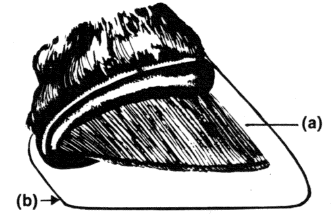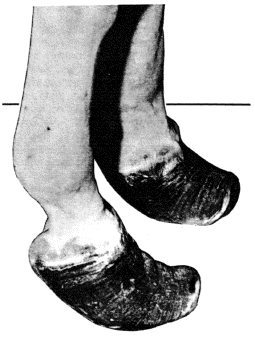
Figure 1. This drawing shows the sensitive lamina (a) of the foot and its relationship to the hoof wall (b).

The normal horse or pony has a smooth, springy, regular gait moving freely, easily, and gracefully. Watching a fine horse move through its paces, it is not difficult to understand man's attraction to the horse as a pleasure animal.
One of the most common ailments which can change this picture rapidly is laminitis. Often called "founder," laminitis is caused by an alteration in the blood supply of the foot which results in damage to the sensitive laminae where the hoof is attached to the foot. The disease may be acute or chronic and may affect one or all four feet at any one time. The forefeet are affected more frequently.
There are many factors that can cause laminitis. Some of the more common are overfeeding, overweight animals lacking exercise, and cold water intake by an overheated animal (metabolic laminitis). Accidental overfeeding, such as a horse breaking into a grain sack, also may result in an attack of founder. Other factors such as metritis (parturient laminitis), local infections, excess weight bearing on one or more legs, running on hard surfaces (traumatic laminitis), and standing for long time periods in transport can cause the problem. Ponies appear to be more susceptible to laminitis than horses. Also, horses between the ages of four and ten years appear to be more susceptible than other horses.
Acute laminitis has a sudden onset. Horses apparently normal in their movement one night may be in severe pain and reluctant to move the following morning. The animal may be standing with all four feet close together, if all four feet are affected, with its head low and its back arched. If only the front feet are affected, the horse will shift the hind legs underneath it to try to put most of its weight on the back feet and vice versa. Also, the animal may be exhibiting an expression of pain and anxiety. In some cases, the pain may be so severe as to cause muscle spasms and profuse sweating. If the horse can be persuaded to move, the gait will be painful and stiff but may improve slightly as the horse "warms up." Acute laminitis is a medical emergency and when a horse shows these signs, a veterinarian should be consulted immediately.
In mildly acute cases, the horse may respond to treatment by a veterinarian if therapy is initiated early in the course of the disease. In severe cases, or in cases with improper or delayed treatment, chronic laminitis is likely to result. In chronic cases, your veterinarian may be able to obtain relief from pain but not effect an immediate cure of the laminitis. The chronic condition may result in the separation of the hoof wall from the sensitive laminae of the foot. When this happens the third phalanx (coffin bone) may rotate downward as in Figure 1. It is then possible for it to penetrate the sole of the hoof and/or produce overgrown feet such as illustrated in Figure 2.
You can help prevent laminitis (founder) if you:

Figure 1. This drawing shows the sensitive lamina (a) of the foot and its relationship to the hoof wall (b).

Figure 2. Overgrown feet which are a result of laminitis.
Reference to products in this publication is not intended to be an endorsement to the exclusion of others which may be similar. Persons using such products assume responsibility for their use in accordance with current label directions of the manufacturer.
Cooperative Extension Work in Agriculture and Home Economics, State of Indiana, Purdue University and U.S. Department of Agriculture Cooperating. H.A. Wadsworth, Director, West Lafayette, IN. Issued in furtherance of the Acts of May 8 and June 30, 1914. It is the policy of the Cooperative Extension Service of Purdue University that all persons shall have equal opportunity and access to our programs and facilities.